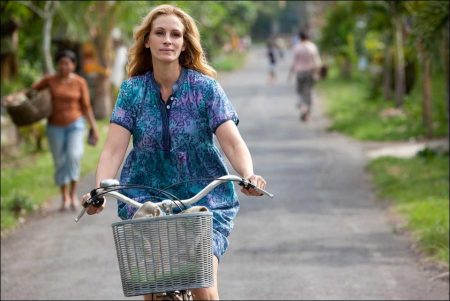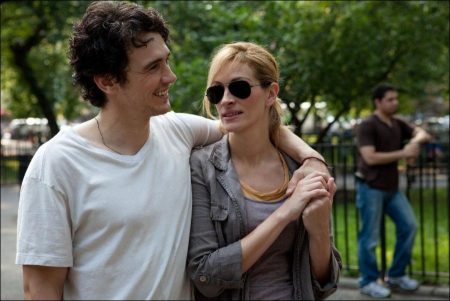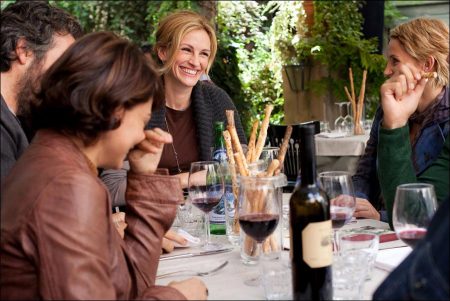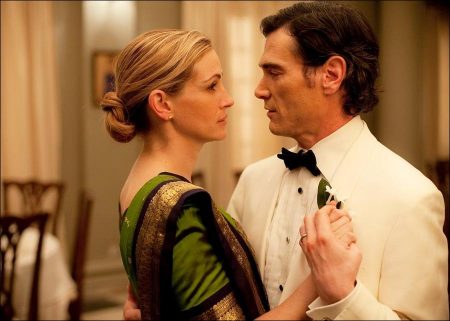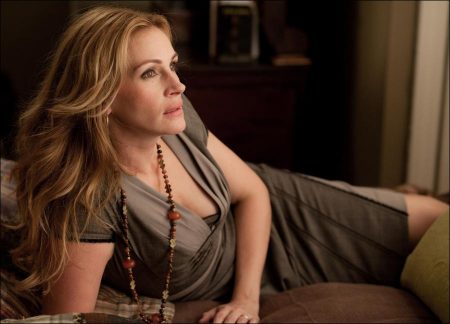Liz Gilbert (Julia Roberts) had everything a modern woman is supposed to dream of having – a husband, a house, a successful career – yet like so many others, she found herself lost, confused, and searching for what she really wanted in life. Newly divorced and at a crossroads, Gilbert steps out of her comfort zone, risking everything to change her life, embarking on a journey around the world that becomes a quest for self-discovery. In her travels, she discovers the true pleasure of nourishment by eating in Italy; the power of prayer in India, and, finally and unexpectedly, the inner peace and balance of true love in Bali.
At 32 years old, Elizabeth Gilbert was educated and had a home, a husband, and a successful career as a writer. However, she was unhappy in her marriage and often spent the night crying on her bathroom floor. In the midst of an affair, she separated from her husband and initiated a divorce, which he contested. The affair continued for some time but did not work out, leaving her devastated and alone. While writing an article on yoga vacations in Bali, she met a ninth-generation medicine man who told her she would come back and study with him.
After finalizing her difficult divorce, she spent the next year traveling around the world. She spent four months in Italy, eating and enjoying life (Eat). She spent four months in India, finding her spirituality (Pray). She ended the year in Bali, Indonesia, looking for “balance” of the two and found love (Love) in the form of a dashing Brazilian factory owner. Gilbert paid for the trip with an advance she received on the book she already planned to write, and “Eat, Pray, Love” is the result.
Julia Roberts read Elizabeth Gilbert’s memoir Eat Pray Love when it was first released in 2006. She sent it to one of her best friends and they read it at the same time, and both immediately connected with the story. “Everybody has a journey, a moment in their lives when they need to redefine who they are and what they’re looking for,” says Roberts. “Liz’s journey is very specific and very visual, in a way that’s very appealing as a story, but it’s also a universal story that can apply to anybody.”
Gilbert’s memoir – a self-described search for everything – has achieved extraordinary success, selling over 6.2 million copies in the United States, and overseas, it has been translated into 40 languages. It is the book that attracted Roberts to the project, along with the chance to work with Ryan Murphy, the film’s co-writer/director. “I love the way the book talks about life experience, searching for answers, and how meaningful people can be in our lives. I think that’s really such a vibrant story. It’s great to be part of it, and part of it with Ryan at the helm of it – it was a delicious endeavor,” says the actress.
Murphy, best known for his work with the Golden Globe-winning television series “Nip/Tuck” and “Glee,” has garnered acclaim for his keen and realistic dialogue. He wrote the screenplay with Jennifer Salt, with whom he previously collaborated on “Nip/Tuck.” “Ryan and Jennifer did a very reverential adaptation,” says Roberts. “Ryan was really in sync with Liz Gilbert and talked to her a lot – they tried to be very true to the book. There comes a moment in any film adaptation where things have to be a little bit different, but we always protected the spine of the story – Liz’s journey of self-discovery.”
“The beauty of the book – and, I think, the reason we all wanted to do it – is that it says, ‘Get out of your box,’” says Murphy. “I love that idea – that was a very personal idea for me, because I can be very rigid in my choices, repeating a pattern day after day after day. For example, I love the scene in Rome where Julia spends the afternoon on the floor, eating a perfect meal. I think of that in my day-to-day life; I try to savor the little experiences and try not to have an outcome to the day. That’s what I learned on a personal level by being part of this project.”
“Ryan handed me the book under completely non-movie circumstances – he recommended it as a friend,” says Salt. “He said, ‘I’m reading this book and I feel like I’m listening to you talk. You’re going to love this.’ And I adored it, because it was so honest, so authentic. When Ryan told me that he was going to get the rights and he wanted me to write it with him… It was just a magical moment for me.”
The book’s theme of being true to one’s self became the driving force behind the story and the script. Though Gilbert makes an exotic and beautiful literal journey, traveling around the world, that is only part of the story. The reason the book has resonated with so many is that her inner journey, her quest for self-discovery, rings true – and it can be done anywhere. Says Gardner, “Liz Gilbert’s curiosity for the unfamiliar is one of the things that was compelling to me. You can literally go around the corner and meet someone you haven’t met before, or encounter a new language, food, culture, or set of behaviors.”
In fact, finding that balance between the external and internal journeys was the key in adapting the material for the screen. The plot that keeps the drama moving forward is Liz’s travel from New York to Italy to India to Indonesia, and it was important to the filmmakers to convey to the audience the personal challenge that Liz poses to herself by traveling around the world by herself: “It’s lonely, and it’s not easy,” says Gardner. It’s that plot that would bring the story off the page and come alive on film.
As they penned the adaptation, Murphy and his screenwriting partner, Jennifer Salt, held brainstorming meetings with Roberts and Gardner, each contributing the parts of the book that resonated most with them. There was much overlap, of course, but also some moments that each related to individually. These intimate discussions became the grass roots for the making of the film script.
Another important resource for Murphy and Salt, of course, was the author, Elizabeth Gilbert. During the writing process, Murphy and Gilbert had a regular email exchange; whenever they had a question about their character’s motivation, they found they had a useful ally in the author herself. For example, when writing the Italy section of the film, it seemed to Murphy and Salt that the Thanksgiving meal with all of her Italian friends would be the key that would unlock the entire act of the film. What was it about that meal that was so important to Gilbert? The author responded that at that moment – at the very beginning of her journey – she was still not sure she could feel happiness for herself, but she was certain she could be happy for others. “She said this moment was like a spark of life,” Gardner says. “It is moments like this that helped us immensely and helped us be able to keep moving forward in the storytelling.”
From the very beginning, when Gardner first read the book, the only choice to play Elizabeth Gilbert was Julia Roberts. “It sang out to me as obvious – this should be Julia Roberts,” says the producer. “I have never worked with Julia before and I am just awestruck by her talent. In this role, she runs the gamut in tone, from vulnerability to toughness and from indecision to confidence. She understands when Liz is ebbing and flowing.”
“Liz goes through a wide range of emotions – as you’d expect, because the story covers a year of her life,” says Roberts. “Between going through divorce and dating and traveling and meeting strangers and not knowing what to do, it’s a great opportunity to play a complex and fascinating character.”
“At the beginning of the movie, Liz is unraveling a bit, and she’s not sure why,” Roberts adds. “She’s a traveler – she’s always traveled – so that was an instinct for her to pack her bags. Obviously, not everybody can do what she did, but it’s not really about that. It’s fun to watch her go around the world in the movie, but it’s really about her own self-examination and figuring out what she wants out of life.”
Roberts says that kind of reflection isn’t easy and it’s what makes Gilbert’s journey remarkable. “For her to take that time for herself is what is deeply interesting and encouraging to other people,” she says. “I think that’s courageous and admirable; it’s such a busy, rapid-fire world, so to try to stop and figure out what’s right for you is a good thing.”
Viola Davis, who plays Delia, Liz’s best friend in the film, says that she too saw the connection between Liz Gilbert and Julia Roberts. “As I was reading Eat Pray Love, I thought to myself, Liz probably doesn’t even realize how fantastic she is. She can make friends as soon as she walks in a room. And I feel the same way about Julia – people are attracted to her spirit. She’s a light.”
Roberts had the opportunity to meet the real Elizabeth Gilbert in Rome. “Ryan had a relationship with her through pre-production, but I felt it was important for me in portraying her to go with my instincts, to get enough filming done that I was already on a course by the time that I met her,” says Roberts. “She’s a lovely, lovely person, and she has a great way of talking and very specific mannerisms, and I didn’t want to imitate her. She’s a beautiful human being.”
Like with the casting of Julia Roberts, the filmmakers couldn’t see any other choice than shooting in the real locations that Gilbert visited on her journey. “That was our holy grail – we were going to go to as many places as we could where Liz Gilbert went,” says Murphy. “Some were easy, especially some of the famous places in Rome that Liz visited.”
In other instances, Murphy says, they were lucky – the production was able to shoot at the real home of Ketut Liyer, a key character in the Bali sequence. “We spent a lot of time in pre-production, going to the different countries three times, finding the exact locations. If we couldn’t shoot at a real location for reasons that were beyond our control, we took an unbelievable amount of pictures and we would re-create them. Because the book is so well-known and loved, it was important to me, as the director, to be true to where she went,” Murphy continues.
Richard Jenkins, who takes on a key role in the India sequence as Richard From Texas, explains what it meant to the film that they were able to shoot in these exotic locations. “When I was a kid, growing up in a small town in the Midwest, movies were how I saw the world. I went places in films that I couldn’t go in any other way,” he says. “So to have this shot in India – you couldn’t have done it anywhere else. The heat, the feeling, the air, the people. It’s a whole different vibe.”
But not only would the production shoot in the real locations. They would also shoot in chronological order – first in New York, then Italy, then India, then Bali. Doing so, Roberts says, added a layer to her performance. “We experienced all the same emotional responses Liz goes through,” she says. “It made it an incredible experience.”
“In talking with Ryan and Dede, it was clear there was something so special about each of these international locations, and people will want to go on a journey similar to Liz’s when they come and see this movie,” says executive producer Stan Wlodkowski. “So it was unanimous by filmmakers and studio alike that we would film in New York, Italy, India, and Bali, in the same progression that Liz experiences in her book. I don’t think I will ever experience again in my career a schedule like this. We were literally making four separate movies.”
One of their first puzzles was in putting together the shooting schedule for the film. Not only would they have to account for the availability of the actors, but local weather, crews, and getting around. Some of the international locations had film infrastructure and had hosted many movies there before, while others, like Bali, had never had a film of this size shoot there.
“When we began shooting in New York, there was always a production office open somewhere in the world. This movie was open for business 24 hours a day. We had casting offices, art departments, construction departments, and wardrobe departments all across the globe,” says Gardner.
Eat, Pray, Love (2010)
Directed by: Ryan Murphy
Starring: Julia Roberts, James Franco, Javier Bardem, Billy Crudup, Richard Jenkins, Viola Davis, Ashlie Atkinson, Lisa Roberts Gillan, Gita Reddy, Jen Kwok, Lisa Roberts Gillan, Mary Testa, Jen Kwok
Screenplay by: Elizabeth Gilbert, Ryan Murphy, Jennifer Salt
Production Design by: Bill Groom
Cinematography by: Robert Richardson
Film Editing by: Bradley Buecker
Costume Design by: Michael Dennison
Art Direction by: Charley Beal
Music by: Dario Marianelli
MPAA Rating: PG-13 for brief strong language, some sexual references and male rear nudity.
Distributed by: Columbia Pictures
Release Date: August 13,

